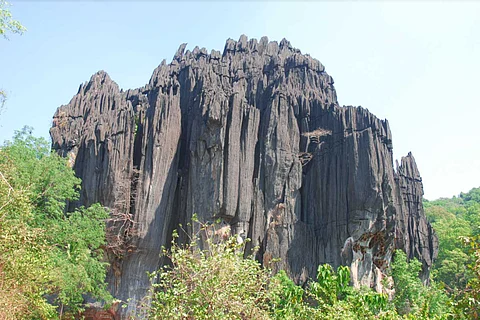

The nip in the air was palpable as we trekked on a muddy trail through a small forest patch. It led us to the foot of a mountain where the legendary rock formations of Yana begin. A stunning sight awaited us: sharp-edged cliffs made of black crystalline rock that stood out against the evergreen Sahyadri Hills and the blue waters of the River Chandika. Until recently, it was a great challenge to reach Yana as there was no motorable road. Only hardcore trekkers could savour the beauty of these rock formations, while the few adventurous tourists had to make their way through dense forests to reach the place – braving thorns, slippery slopes and wild animals.
Located deep inside the evergreen forests of the Western Ghats, between Kumta and Sirsi in Karnataka, Yana is home to a cluster of nearly 61 rock formations, of different sizes and shapes, sprawled over three square kilometres.
Yana has something for everyone – the pilgrim, the trekker and the nature lover. An annual festival here during Shivratri draws hordes of pilgrims who circumambulate the Shikharas. The deep lush greenery and sounds of water flowing through valleys and gorges, adjacent to Yana, and the echoes of bird calls are a major draw for nature enthusiasts. The rare and exotic wildflowers that grow in profusion on the hillsides add to the charm of the place.
The twin pinnacles, the enchanting greenery, the wondrous caves around the peaks, the innumerable beehives on the rocks and the crystal-clear waters of the Chandika River in the environs of Yana formed the backdrop of the Kannada movie, Nammoora Mandara Hoove in the early nineties. It was after the release of this blockbuster, that bus-loads of tourists rushed to explore the awesome rock formations in the Uttara Kannada district.
Soaring rock formations amid greenery
The formidable boulders, roaring cascades, an ancient temple replete with legends, the soothing greenery all around, and the tranquillity act as a balm for your tired nerves. Of the 61 rock formations scattered across the jungle floor, the most celebrated are the twin pinnacles of Bhairaveshwara and Jaganmohini. Named after the incarnations of Lord Shiva and Vishnu, they stand tall at 120 metre and 90 metre, respectively. The needle-sharp peaks of these two monoliths seem to jab the sky. The taller of the two rocks is the Bhairaveshwara Shikhara and the other is the Mohini Shikhara. Yana has mythological significance, as is common with all such places, and is also the epicentre of many legends.
A popular legend associated with Yana holds that Bhasmasura, a malevolent demon, performed penance to Lord Shiva and obtained the power to reduce anyone to ashes by placing his hand on their head. An ungrateful Bhasmasura however, soon decided to test the boon on his benefactor. Devotees believe that when Bhasmasura pursued Shiva with the intention of destroying him, Shiva came down to earth and hid in the dark nooks of the Bhairaveshwara peak of Yana. Seeing his plight, Vishnu assumed the form of a seductive female dancer – Mohini – and managed to win Bhasmasura’s affections. She challenged him to a dance competition and induced him to place his hand on his head. The unwitting demon did just that and was reduced to a heap of ashes. Legend has it that the other peak is called Jaganmohini in honour of Vishnu, who took the form of Mohini and saved Lord Shiva’s life.
During our visit to the rock formations, we sighted bats and bees swarming the cavernous boulders. The profusion of beehives on overhanging rocks is an interesting feature in Yana. According to the temple authorities, the bees guard the sanctity and serenity of the place. At the slightest irritation or disturbance, they attack the trouble-makers. We were warned not to disturb the wild bees as they are considered guardians of the cave temples.
Beehives on the rocks
Geologically, these rocks were formed millions of years ago. The black colour of the rocks is due to iron, manganese and silica present in them. Sadly, the vagaries of time have caused these limestone structures to turn blackish brown. Legend has it that the heat generated in the combustion of Bhasmasura was so intense that the limestone – which the rocks are composed of – turned black. Adding credence to this legend is the presence of loose black soil scattered around the monoliths which locals believe are the demon’s ashes.
With the construction of a road that culminates 500 metre short of the foot of the mountain, tourists have drastically increased here. The necessity arises to restrict the number of tourists and also accord a special protection status to Yana, as the place is also considered as a biodiversity hotspot of the Sahyadri hill range. Hence, there is a need to protect the area under the Biodiversity Preservation Act, 2002.
Getting there: Yana is located 25 km from Kumta, 40 km from Sirsi, and 55 km from Gokarna.
Stay: While there are no accommodations available in Yana. Sirsi and Kumta have some reasonably good and moderately priced hotels.
All photos by Susheela Nair.
Susheela Nair is an Independent Food, Travel & Lifestyle Writer & Photographer contributing articles, content and images to several publications, travel portals, guide books, brochures and coffee table books.